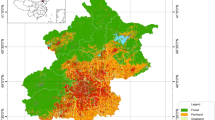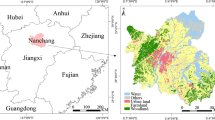Abstract
The structure of interconnected ecological network in cities includes corridors and large green spots continuity which provides ecosystem services, e.g. biodiversity conservation. From a functional perspective, green infrastructure would be one of the most adapted ways of solving environmental issues caused by restricted vegetation in intensive urban areas with high density of gray infrastructures. In this study, green infrastructures of Hamadan with an area of about 74.22 km2 across 75 districts, (including agricultural lands, Parks, gardens and vacant lands) were classified as Service Providing Units (SPUs). Gardens and parks classes with dense tree cover as well as high ecosystem standards, were selected as green habitat patches, including 205 patches in the study area. Considering the highest quality of habitats, 14 patches were chosen as habitat cores based on having the highest level of COHESION metric, and the area of more than 12 ha. We performed the Least Cost Path (LCP) method through QGIS software at the study area to see core habitats connectivity; using a simple algorithm to calculate the cumulative cost of moving through landscape. Results show that a total of 91 potential corridors were identified connecting the main cores. Optimal corridor selection was based on two scenarios, the shortest and the least costly route. Therefore 23 and 54 corridors were selected. By combination of two scenarios and considering the overlap of some routes, the final corridors were also identified. To keep up network connectivity, in the case of Corridor 6–9 with high costs over threshold, stepping-stones have been defined to reduce costs and distance.










Similar content being viewed by others
References
Abdolahzade Fard A (2017) Urban natural corridors sustainable design with ecological approach by using quantitative strategic planning matrix (QSPM) and SWOT analysis (Case study: Soltanabad River, Shiraz). Q Geogr (Regional Planning) 27(1):127–148 (in Persian)
Abedian S, Salman Mahiny AR, Alizadeh A, Khorasani NA (2015) Using least cost pathway in road routing in Kordkuy, Bandar-e-Gaz and Galugah towns. Geogr Plan Space Q J 5(15):81–94 (in Persian)
Adriaensen F, Chardon JP, De Blust G, Swinnen E, Villalba S, Gulinck H, Matthysen E (2003) The application of ‘least-cost’ modeling as a functional landscape model. Landscape Urban Plan 64:233–247
Alexander JL, Sarah KO, Kristy LSB, Marco R (2016) Use of least-cost path analysis to identify potential movement corridors of swift foxes in Montana. J Mammal 97(3):891–898
Alonso-Monasterio M, Alonso-Monasterio P, Viñals M (2015) Natusers’ motivations and attitudes in urban green corridors: challenges and opportunities. Case study of the Parc Fluvial del Túria (Spain). Boletin de la Asociacion de Geografos Espanoles 68:369–383
Aziz HA, Rashidi MH (2014) The role of green corridors for wildlife conservation in urban landscape: a literature review. IOP Conf Ser: Earth Environ Sci 18:012093
Beier P, Majka D, Jenness J (2006) Conceptual steps for designing wildlife corridors. Corridor Des Ariz USA 269:23784–23789
Beier P, Majka DR, Spencer WD (2008) Forks in the road: choices in procedures for designing wild land linkages. J Conserv Biol 22:836–851
Benedict MA, McMahon ET (2002) Green infrastructure: smart conservation for the twenty-first century. Renew Resour J 20(3):12–17
Bennett AF (1990) Habitat corridors and the conservation of small mammals in a fragmented forest environment. Landscape Ecol 4:109–122
Chon JH (2004) Aesthetic responses to urban greenway trail corridors: implications for sustainable development in tourism and recreation settings. Office of Graduate Studies of Texas A&M University in partial fulfillment of the requirements for the degree of DOCTOR OF PHILOSOPHY, Texas, USA, 248 pp. https://pdfs.semanticscholar.org/8406/1561ff4d0352b63fef80d9ad5e28485dfdf6.pdf?_ga=2.187402216.1345700010.1592477176-143588217.1565164990
Contrerasa RC, Rosas LEQ (2017) Analyzing scale, quality and diversity of green infrastructure and the provision of urban ecosystem services: a case from Mexico City. Ecosyst Serv 23:127–137
De Montis A, Caschili S, Mulas M, Modica GA, Ganciu BA, Ledda A, Dessena L, Laudari L, Fichera CR (2016) Urban-rural ecological networks for landscape planning. Land Use Policy 50:312–327
EEA (European Environmental Agency) (2011) Green infrastructure and territorial cohesion. The concept of green infrastructure and its integration into policies using monitoring systems. European Environment Agency, Luxembourg
Elmqvist T, Fragkias M, Goodness J, Güneralp B, Marcotullio PJ, McDonald RI, Parnell S, Schewenius M, Sendstad M, Seto KC, Wilkinson C (2013) Urbanization, biodiversity and ecosystem services: Challenges and opportunities: A global assessment. Springer, Dordrecht, pp 771
Gilbert-Norton L, Wilson R, Stevens JR, Beard KH (2010) A meta-analytic review of corridor effectiveness. Conserv Biol 24:660–668
Gurrutxaga M, Lozano PJ, Barrio G (2010) GIS-based approach for incorporating the connectivity of ecological networks into regional planning. J Nat Conserv 18:318–326
Holyoak M, Mathew A, Leibold MA (2005) Metacommunities: spatial dynamics and ecological communities. The University of Chicago Press, Chicago, p 520
Kamyab H, Salman Mahiny AR, Shahraini M (2017) Comparison of ecosystem- based land allocation using genetic algorithm and MOLA. Environ Res 7(14):157–168 (in Persian)
Kati V, Jari N (2016) Bottom-up thinking – identifying socio-cultural values of ecosystem services in local blue–green infrastructure planning in Helsinki, Finland. Land Use Policy 50:537–547
Kong F, Yin H, Nakagoshi N, Zong Y (2010) Urban green space network development for biodiversity conservation: identification based on graph theory and gravity modeling. Landscape Urban Plan 95:16–27
Minor ES, Urban D (2007) A graph-theory framework for evaluating landscape connectivity and conservation planning. Conserv Biol 22(2):297–307
Mitsova D, Shuster W, Wang X (2011) A cellular automata model of land cover changes to integrate urban growth with open space conservation. Landscape Urban Plan 99:141–153
Parivar P, Sotoudeh A, Yavari AR (2008) A landscape – based analysis of spatial distribution and dynamics of Tehran urban green spaces. J Environ Stud 34(45):79–90 (in Persian)
Parker K, Head LM, Chisholm LA, Feneley N (2008) A conceptual model of ecological connectivity in the Shellharbour Local Government Area, New South Wales, Australia. Landscape Urban Plan 86:47–59
Pauleit S, Liu L, Ahern J, Kazmierczak A (2011) Multifunctional green infrastructure planning to promote ecological services in the city. In: Douglas I, Goode D, Houck M, Maddox D (eds) Handbook of urban ecology. Routledge, London, pp 272–285
Rezaei F, Falahatkar S, Dadashpoor H (2017) Spatial and Temporal change of costal and non-costal urban form in Mazandaran province using landscape metrics. Town Country Plan 9(1):57–79 (in Persian)
Rostami M, Kiamehr R, Bayat R (2016) A knowledge-based approach to inter-layer weighting for optimal route location using geospatial information system (GIS) (case study: Ilam-Homeil road). Sci-Res Q Geogr Data (SEPEHR) 24(96):5–19 (in Persian)
Saboonchi P, Abarghouyi H, Motedayen H (2018) Green landscape networks; the role of articulation in the integrity of green space in landscapes of contemporary cities of Iran. Bagh-E Nazar J 15(62):5–16
Salman Mahini AR, Kamyab H (2010) Applied remote sensing and GIS with IDRISI, 1st edn. Mehr Mahdis Publication, D.O.E Golestan Environment Head Office, Gorgan, IRAN, pp 582 (In Persian)
Sawyer SC, Epps CW, Brashares JS (2011) Placing linkages among fragmented habitats: do least-cost models reflect how animals use landscapes. J Appl Ecol 48:668–678
Sirakaya A, Cliquet A, Harris J (2017) Ecosystem services in cities: towards the international legal protection of ecosystem services in urban environments. Ecosyst Serv 29:205–212
Toledo MCB, Donatelli RJ, Batista GT (2011) Relation between green spaces and bird community structure in an urban area in Southeast Brazil. Urban Ecosyst 15:111–131
de Torre R, Jiménez MD, Ramírez Á, Mola I, Casado MA, Balaguer L (2015) Use of restoration plantings to enhance bird seed dispersal at the roadside: failures and prospects. J Environ Eng Landscape Manag 23(4):1–10
Wiens JA (1997) Metapopulation dynamics and landscape ecology. In: Hanski IA, Gilpin ME (eds) Metapopulation biology: ecology, genetics and evolution. Academic Press, San Diego, pp 43–67
Yu D, Xun B, Shi P, Shao H, Liu Y (2012) Ecological restoration planning based on connectivity in an urban area. Ecol Eng 46:24–33
Zhang Z, Meerow S, Newell JP, Lindquist M (2018) Enhancing landscape connectivity through multifunctional green infrastructure corridor modeling and design. Urban For Urban Green 38:305–317
Acknowledgements
Funding was provided by the Iran National Science Foundation (INSF) under contract number 96016363.
Author information
Authors and Affiliations
Corresponding author
Rights and permissions
About this article
Cite this article
Gharibi, S., Shayesteh, K. & Attaeian, B. Interconnected ecological network design using lcp algorithm and cohesion index in urban scale. Urban Ecosyst 24, 153–163 (2021). https://doi.org/10.1007/s11252-020-01016-z
Published:
Issue Date:
DOI: https://doi.org/10.1007/s11252-020-01016-z




